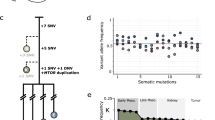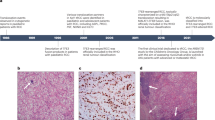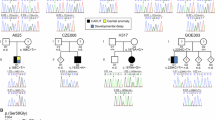Abstract
WILMS' tumour is an embryonic kidney tumour thought to arise through aberrant mesenchymal stem cell differentiation1 and to result from loss of function of a 'tumour suppressor' gene(s)2. Both sporadic and syndrome-associated Wilms' tumours are accompanied by an increased frequency of abnormalities of the urinary tract and genitalia3. Deletional analysis of individuals with the WAGR syndrome4–8 (for, Wilms' tumour, aniridia, genitourinary abnormalities and mental retardation) showed that a Wilms' tumour gene lies at chromosomal position 11p13. This led to the isolation of a candidate Wilms' tumour gene9,10, encoding a zinc-finger protein which is likely to be a transcription factor. To gain insight into the role of this candidate gene in normal development and tumorigenesis, we have now performed in situ messenger RNA hybridization on sections of human embryos and Wilms' tumours. The candidate Wilms' tumour gene is expressed specifically in the condensed mesenchyme, renal vesicle and glomerular epithelium of the developing kidney, in the related mesonephric glomeruli and in cells approximating these structures in tumours. The other main sites of expression are the genital ridge, fetal gonad and mesothelium. These data suggest that (1) this candidate is indeed a Wilms' tumour gene, (2) the associated genital abnormalities are pleiotropic effects of mutation in the Wilms' tumour gene itself, in support of recent genetic analysis11, and (3) this gene has a specific role in kidney development and a wider role in mesenchymal–epithelial transitions.
This is a preview of subscription content, access via your institution
Access options
Subscribe to this journal
Receive 51 print issues and online access
$199.00 per year
only $3.90 per issue
Buy this article
- Purchase on SpringerLink
- Instant access to full article PDF
Prices may be subject to local taxes which are calculated during checkout
Similar content being viewed by others
References
Bennington, J. L. & Beckwith, J. B. in Atlas of Tumor Pathology, Second Series, Fascicle 12 (Armed Forces Institute of Pathology, Washington, DC, 1975).
Cavenee, W., Hastie, N. & Stanbridge, E. (eds) in Recessive Oncogenes and Tumor Suppression (Cold Spring Harbor Laboratory, New York, 1989).
Breslow, N. E. & Beckwith, J. B. J. natn. Cancer Inst. 68, 429–436 (1982).
Riccardi, V. M., Sujanski, E., Smith, A. C. & Francke, U. Pediatrics 61, 604–610 (1978).
van Heyningen, V. et al. Proc. natn. Acad. Sci. U.S.A. 82, 8592–8596 (1985).
Glaser, T. et al. Nature 321, 882–887 (1986).
Compton, D. A. et al. Cell 55, 827–836 (1988).
Davis, L. M. et al. Science 241, 840–842 (1988).
Call, K. M. et al. Cell 60, 509–520 (1990).
Gessler, M. et al. Nature 343, 774–778 (1990).
van Heyningen, V. et al. Proc. natn. Acad. Sci. U.S.A. (in the press).
Saxen, L. Organogenesis of the Kidney (Cambridge University Press, 1987).
Potter, E. L. Normal and Abnormal Development of the Kidney (Year Book Medical Publishers, Inc., Chicago, 1972).
Grundy, P. et al. Nature 336, 374–376 (1988).
Huff, V. et al. Nature 336, 377–378 (1988).
Mannens, M. et al. Hum. Genet. 81, 41–48 (1988).
Koufos, A. et al. Am. J. hum. Genet. 44, 711–719 (1989).
Goddard, A. D. et al. Molec. cell. Biol. 8, 2082–2088 (1988).
Dunn, J. M., Phillips, R. A., Becker, A. J. & Gallie, B. L. Science 241, 1797–1800 (1988).
Lee, W. H. et al. Science 235, 1394–1399 (1987).
Drash, A., Sherman, F., Hartmann, W. H. & Blizzard, R. M. J. Pediat. 76, 585–593 (1970).
Byskov, A. G. Physiol. Rev. 66, 71–117 (1986).
Burgoyne, P. S. Nature 342, 860–862 (1989).
Maniatis, T., Fritsch, E. F. & Sambrook, J. (eds) Molecular Cloning: A Laboratory Manual (Cold Spring Harbor Laboratory, New York, 1982).
Thompson, A. M. et al. Br. J. Cancer 61, 74–78 (1990).
Davidson, D., Graham, E., Sime, C. & Hill, R. Development 104, 305–316 (1988).
Edwards, Y. H., Lloyd, J. C., McMillan, S. L. & Benham, F. J. Molec. cell. Biol. 5, 2147–2149 (1985).
Elder, J. K., Green, D. K. & Southern, E. M. Nucleic Acids Res. 14, 417–425 (1986).
Ekblom, P. Med. Biol. 59, 139–160 (1981).
Fleming, S. thesis, Univ. Glasgow (1988).
Polak, J. M., van Noorden, S. (eds) Immunocytochemistry: Practical Applications in Pathology and Biology (Wright, Bristol, 1983).
Author information
Authors and Affiliations
Rights and permissions
About this article
Cite this article
Pritchard-Jones, K., Fleming, S., Davidson, D. et al. The candidate Wilms' tumour gene is involved in genitourinary development. Nature 346, 194–197 (1990). https://doi.org/10.1038/346194a0
Received:
Accepted:
Issue Date:
DOI: https://doi.org/10.1038/346194a0



